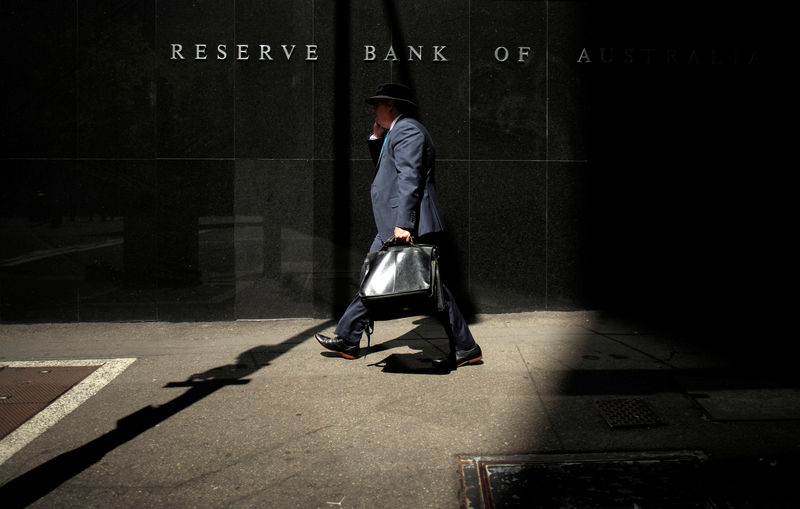By Swati Pandey
SYDNEY (Reuters) - Australia's strong economic performance of recent decades has allowed its central bank to avoid the kinds of unorthodox policies seen in other countries, but record low rates mean less conventional measures may be needed to tackle new challenges.
The Reserve Bank of Australia (RBA) is all but certain to cut its benchmark interest rate--perhaps as early as Tuesday--amid a rapid decline in home prices, weak consumer inflation and insipid wage growth.[AU/INT]
Compared with previous cycles, however, the central bank has far less policy ammunition to stabilize the economy with only 150 basis points of easing left before it hits 0 percent. That rules out cuts of the magnitude used in past downturns.
Such constraints have for the first time raised speculation the RBA may need to look at options outside the cash rate mechanism. The possibilities range from expanded daily bond purchases through to more extreme ideas such as quantitative easing and so-called helicopter money.
"At the moment, the RBA has enough policy arsenal for a modest interest rate reduction but it's nowhere near their average cutting cycle since 1995 which has been 3 percent," said Matthew Sherwood, Sydney-based head of investment strategy at fund manager Perpetual and a former RBA economist.
Financial markets are pricing in the chance of two cuts to 1.00 percent this year. The RBA meets on May 7 and 17 of 42 economists polled by Reuters predict a 25-basis-point easing to help stoke inflation and revive the slumping housing market.
"The downside risk from that outlook is if a weaker domestic economy forces a fuller easing cycle that will test the effective lower bound (of zero)," Sherwood added.
The central bank has not publicly spoken about a "lower bound" for rates. In a speech in December Deputy Governor Guy Debelle told an audience it was the level of interest rates that mattered and that they "can still move lower."
(GRAPHIC: Benchmark rates in developed world, https://tmsnrt.rs/2WnHdRo)
The RBA was one of the few major central banks in the world which did not adopt zero or negative interest rates after the 2008 global financial crisis. Neither did it resort to massive bond buying or balance sheet expansion like the U.S. Federal Reserve or the European Central Bank.
The central bank's easing cycle then had lasted eight months and saw it cut rates by 425 basis points to 3.0 percent. The RBA again slashed rates by 325 basis points between November 2011 and August 2016 to 1.50 percent where they are now.
There is an argument against negative interest rates as Australia runs a current account deficit and is a capital importing nation. Indeed, only four of 42 economists polled last month predicted the RBA to ease below 1.00 percent. [AU/INT]
In duress, the RBA does have a tried and tested option should the housing market really collapse and bank stress levels elevate.
In such a scenario, banks are likely to claw back on lending like they did during the 2008/09 financial crisis. The RBA had then rapidly expanded its balance sheet by flooding the banking system with cheap cash using its daily money market operations, mostly to meet liquidity requirements, a process that proved highly successful.
If the need arises, the RBA could easily lend to banks for longer and at lower rates than the official rate, albeit with some strings attached to ensure they expand their loan books.
"I think the RBA is more likely to do something like that than helicopter money which, to me, is too hard to calibrate," said Sherwood.
HELICOPTER RESCUE?
The idea of "helicopter money" in Australia was raised by Citibank chief economist Paul Brennan who last week published a note titled "Time for the RBA to Deploy the Helicopters?", following disappointing first-quarter inflation.
(GRAPHIC: Real interest rate in Australia is close to zero, https://tmsnrt.rs/2WjIJUB)
This would involve the government giving cash handouts to households financed directly by the RBA, perhaps by the central bank buying perpetual bonds from the government.
"Helicopter money can be designed to boost economic efficiency (e.g. lower unemployment) whilst limiting negative spillovers to other areas like financial systems stability (e.g. asset bubble risks) and distributional equity (e.g. wealth inequality)," Brennan said.
While "helicopter money" has been deliberated overseas, no central bank has yet deployed it.
Then there is quantitative easing (QE), whereby central banks buy government and other securities from the market aiming to lower yields and so borrowing costs, particularly for home loans.
That is unlikely to be as effective in Australia since home loan rates are benchmarked to the cash rate, and not to bond yields. Moreover, much of the stock of Australia's triple-A rated debt is held by offshore central banks as part of their currency reserves, and by domestic lenders to meet regulatory requirements. That makes them reluctant sellers.
Economists believe the RBA will at some point soon need to shift away from its reluctance to ease policy, which it says is already "stimulatory".
With a national election just around the corner in Australia, however, central bankers will be hoping for massive government spending to do some of the heavy lifting in supporting growth.
"Policy capacity matters, both monetary and fiscal," RBA's Debelle said in December in a speech titled "Lessons and Questions from the GFC". "Fiscal space is really important. We still have that in Australia."

(GRAPHIC: Australia's economy, consumer spending slows; terms of trade jumps, https://tmsnrt.rs/2WkeZGZ)